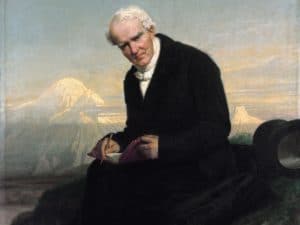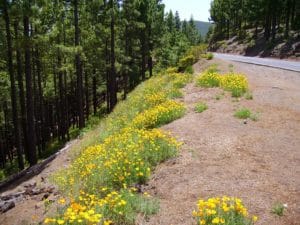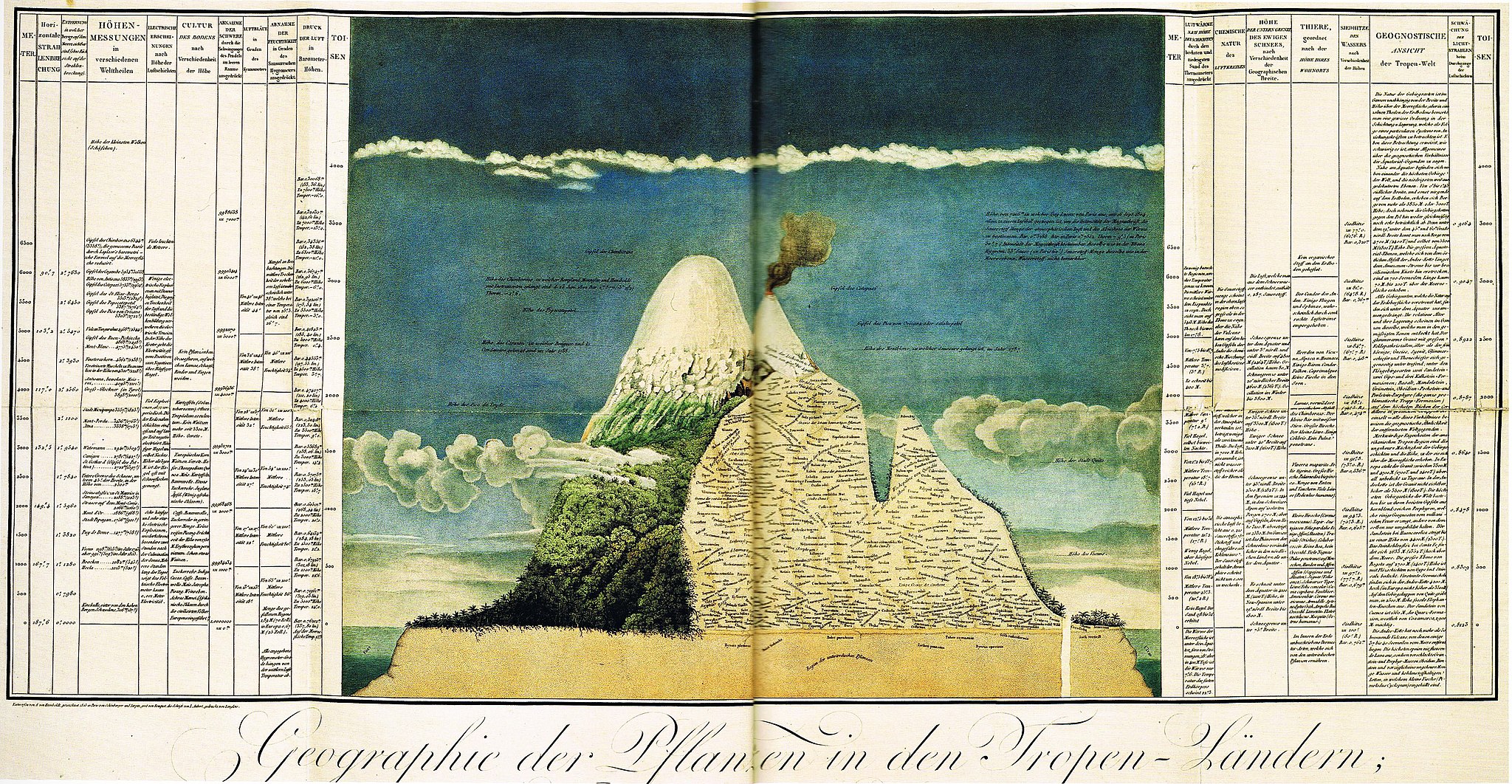Changing the Mountain Picture
[caption id="attachment_3179" align="alignright" width="300"] 'Baron Alexander von Humboldt,' by Julius Schrader. Humboldt chose the Ecuadorian mountains Chimborazo & Cotopaxi for the portrait's background.
'Baron Alexander von Humboldt,' by Julius Schrader. Humboldt chose the Ecuadorian mountains Chimborazo & Cotopaxi for the portrait's background.
And there is another huge difference today from the time of Humboldt: he and his travelling companions, such the French botanist and explorer Aimé Bonpland, needed all their physical power to climb the pristine mountain ecosystems. Today, we can often simply take our cars and drive up a paved mountain road. These roads not only facilitate us reaching remote places high up the mountains, but also act as a means of transportation for hitch-hiking plants. So how does this affect the plant diversity patterns we find today?
[caption id="attachment_3180" align="alignleft" width="300"] North-American Conyza canadensis along a road in the Swiss Alps.
North-American Conyza canadensis along a road in the Swiss Alps.
Some unexpected results...
In a global effort by the Mountain Invasion Research Network (MIREN), we took our cars, 'climbed' mountains worldwide, and recorded all species we found along the road. We also recorded the species found up to 100 meters away from the road, in semi-natural areas more similar to those that Humboldt would have encountered. To our knowledge, this was the first global effort to measure local alpha diversity in mountains and also how it changes in the landscape (beta diversity) with a standardized sampling method.
We were expecting to detect a universal pattern of how species richness is distributed along the elevation gradients. Instead, we found great variation in these patterns. We had to accept that the patterns in semi-natural habitats away from the road were rather region-specific: we found declining species richness with increasing elevation in some regions, but increasing richness in others. In some regions species richness peaked at mid-elevations, but there was no relationship with elevation in other regions.
[caption id="attachment_3181" align="alignright" width="300"] Californian poppy, a non-native species on Tenerife that spread towards high elevations along roadsides.
Californian poppy, a non-native species on Tenerife that spread towards high elevations along roadsides.
...And interesting consistencies
However, by having a closer look we were able to find some interesting and informative (or worrying?) consistencies. Our studied regions were different with respect to where species richness (alpha diversity) peaked as long as we were looking at semi-natural sites. However, along roadsides we found the highest species richness almost always at mid-elevations. This is likely the case because species can 'move' along roads more easily, thus covering larger elevational ranges overall, which leads to a stronger range overlap at mid-elevations. The second and more important reason is that in all regions non-native species have spread along roads from the lowlands to high elevations. This consistent elevational distribution pattern of non-native species overlaps with the individual native species' patterns. But that's not all. The uniqueness of species communities was also reduced by mountain roads and non-native species, and we found that plant communities became more similar. This means that the so-called diversity at the landscape scale (beta diversity) has been reduced.
[caption id="attachment_3182" align="alignleft" width="300"] Roads and settlements creeping up the slopes of Mount Teide on Tenerife.
Roads and settlements creeping up the slopes of Mount Teide on Tenerife.
Mountains continue to hold a similar fascination for people today as they did in Humboldt's time. This fascination and our modern technological possibilities lead to the ongoing utilization of mountain ecosystems - for settlements, agriculture, tourism, sport, and so on. Unfortunately, all these activities will inevitably bring more roads and thus more dispersal pathways for non-native species, and will modify environmental conditions for native species. We can expect more and more change in diversity patterns in mountains as the human footprint and its associated global changes increases. We can only wonder how Alexander von Humboldt’s ‘Naturgemälde’ (or paintings of nature) would look today; one of our study regions, for example, was Mount Teide on Tenerife, the first stop on Humboldt's journey to the Americas. No doubt that humans have changed the mountain ‘picture.'
Further reading: Haider, S., Kueffer, C., Bruelheide, H., Seipel, T., Alexander, J.M., Rew, L.J., Arévalo, J.R., Cavieres, L.A., McDougall, K.L., Milbau, A., Naylor, B.J., Speziale, K. & Pauchard, A. (2018) Mountain roads and non‐native species modify elevational patterns of plant diversity. Global Ecology and Biogeography. Early View. DOI: 10.1111/geb.12727
This post was written by Sylvia Haider, an assistant professor at Martin Luther University Halle-Wittenberg. As one of the current chairs of MIREN, her research focuses on patterns of taxonomic and functional diversity along elevation gradients.
[caption id="attachment_3178" align="aligncenter" width="2048"] Alexander von Humboldt - Geographie der Pflanzen in den Tropen-Laendern
Alexander von Humboldt - Geographie der Pflanzen in den Tropen-Laendern
 'Baron Alexander von Humboldt,' by Julius Schrader. Humboldt chose the Ecuadorian mountains Chimborazo & Cotopaxi for the portrait's background.
'Baron Alexander von Humboldt,' by Julius Schrader. Humboldt chose the Ecuadorian mountains Chimborazo & Cotopaxi for the portrait's background.How do mountain roads and non-native species affect mountain biodiversity?
Next year, we will celebrate 250 years since the birth of the German geographer, naturalist, and explorer Alexander von Humboldt. Few people had such a strong influence on modern science – and on ecology in particular. One of Humboldt's strongest interests was investigating how species richness and community composition change along elevational gradients. He was obsessed with the idea of climbing all the mountains he came across during his travels, and many of us probably have his famous drawings in mind, in which he noted down all species names and vegetation zones he found from the bottom to the top of each one. However, although the idea of investigating how the number of species varies with elevation is a rather old one, we still do not know how general such species richness patterns are and what mechanisms lie behind them.And there is another huge difference today from the time of Humboldt: he and his travelling companions, such the French botanist and explorer Aimé Bonpland, needed all their physical power to climb the pristine mountain ecosystems. Today, we can often simply take our cars and drive up a paved mountain road. These roads not only facilitate us reaching remote places high up the mountains, but also act as a means of transportation for hitch-hiking plants. So how does this affect the plant diversity patterns we find today?
[caption id="attachment_3180" align="alignleft" width="300"]
 North-American Conyza canadensis along a road in the Swiss Alps.
North-American Conyza canadensis along a road in the Swiss Alps.Some unexpected results...
In a global effort by the Mountain Invasion Research Network (MIREN), we took our cars, 'climbed' mountains worldwide, and recorded all species we found along the road. We also recorded the species found up to 100 meters away from the road, in semi-natural areas more similar to those that Humboldt would have encountered. To our knowledge, this was the first global effort to measure local alpha diversity in mountains and also how it changes in the landscape (beta diversity) with a standardized sampling method.
We were expecting to detect a universal pattern of how species richness is distributed along the elevation gradients. Instead, we found great variation in these patterns. We had to accept that the patterns in semi-natural habitats away from the road were rather region-specific: we found declining species richness with increasing elevation in some regions, but increasing richness in others. In some regions species richness peaked at mid-elevations, but there was no relationship with elevation in other regions.
[caption id="attachment_3181" align="alignright" width="300"]
 Californian poppy, a non-native species on Tenerife that spread towards high elevations along roadsides.
Californian poppy, a non-native species on Tenerife that spread towards high elevations along roadsides....And interesting consistencies
However, by having a closer look we were able to find some interesting and informative (or worrying?) consistencies. Our studied regions were different with respect to where species richness (alpha diversity) peaked as long as we were looking at semi-natural sites. However, along roadsides we found the highest species richness almost always at mid-elevations. This is likely the case because species can 'move' along roads more easily, thus covering larger elevational ranges overall, which leads to a stronger range overlap at mid-elevations. The second and more important reason is that in all regions non-native species have spread along roads from the lowlands to high elevations. This consistent elevational distribution pattern of non-native species overlaps with the individual native species' patterns. But that's not all. The uniqueness of species communities was also reduced by mountain roads and non-native species, and we found that plant communities became more similar. This means that the so-called diversity at the landscape scale (beta diversity) has been reduced.
[caption id="attachment_3182" align="alignleft" width="300"]
 Roads and settlements creeping up the slopes of Mount Teide on Tenerife.
Roads and settlements creeping up the slopes of Mount Teide on Tenerife.Mountains continue to hold a similar fascination for people today as they did in Humboldt's time. This fascination and our modern technological possibilities lead to the ongoing utilization of mountain ecosystems - for settlements, agriculture, tourism, sport, and so on. Unfortunately, all these activities will inevitably bring more roads and thus more dispersal pathways for non-native species, and will modify environmental conditions for native species. We can expect more and more change in diversity patterns in mountains as the human footprint and its associated global changes increases. We can only wonder how Alexander von Humboldt’s ‘Naturgemälde’ (or paintings of nature) would look today; one of our study regions, for example, was Mount Teide on Tenerife, the first stop on Humboldt's journey to the Americas. No doubt that humans have changed the mountain ‘picture.'
Further reading: Haider, S., Kueffer, C., Bruelheide, H., Seipel, T., Alexander, J.M., Rew, L.J., Arévalo, J.R., Cavieres, L.A., McDougall, K.L., Milbau, A., Naylor, B.J., Speziale, K. & Pauchard, A. (2018) Mountain roads and non‐native species modify elevational patterns of plant diversity. Global Ecology and Biogeography. Early View. DOI: 10.1111/geb.12727
This post was written by Sylvia Haider, an assistant professor at Martin Luther University Halle-Wittenberg. As one of the current chairs of MIREN, her research focuses on patterns of taxonomic and functional diversity along elevation gradients.
[caption id="attachment_3178" align="aligncenter" width="2048"]
 Alexander von Humboldt - Geographie der Pflanzen in den Tropen-Laendern
Alexander von Humboldt - Geographie der Pflanzen in den Tropen-LaendernRelated Posts
By accepting you will be accessing a service provided by a third-party external to https://mountainresearchinitiative.org/






